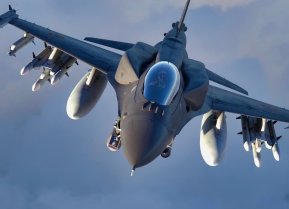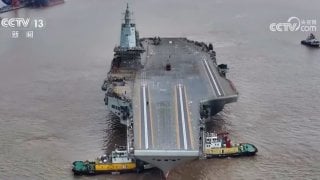New Images Showcase China's New Aircraft Carrier
The People's Liberation Army Navy's (PLAN's ) third and newest aircraft carrier is on track to begin sea trials later this year, and this week, Chinese state media released new images of the advanced warship. Images of the Type 003 Fujian were shared on China Central Television (CCTV).
The People's Liberation Army Navy's (PLAN's ) third and newest aircraft carrier is on track to begin sea trials later this year, and this week, Chinese state media released new images of the advanced warship. Images of the Type 003 Fujian were shared on China Central Television (CCTV).
It was further reported that the goal is to test the ship's capabilities this year, while the ship should be in service well in advance of the Chinese People's Liberation Army (PLA) centennial celebrations in 2027.
Song Zhongping, a Chinese military expert and TV commentator, told the Global Times on Wednesday that Yin's remarks showed that the Type 003 Fujian remains in the mooring trial phase for the time being but is holding intensive tests. The carrier began launch tests of its electromagnetic catapult system in November.
The Fujian will be the only aircraft carrier in the world, apart from the U.S. Navy's USS Gerald R. Ford (CVN-78) nuclear-powered supercarrier, to be equipped with the latest Electromagnetic Aircraft Launch System (EMALS). The system will allow the Chinese carrier to launch more types of aircraft than the Type 002 Shandong or the Type 001 Liaoning, while it will also be more reliable and energy-efficient, marking a milestone in the modernization of the Chinese military.
The U.S. Navy's Nimitz-class and the French Navy flagship Charles de Gaulle employ steam-powered launch catapults, a system developed after the Second World War. However, all future Gerald R. Ford-class carriers will be equipped with an electromagnetic system.
China's Growing Naval Might
The 80,000-ton vessel is also China's first domestically designed and built catapult-equipped carrier.
The Type 003 carrier left its drydock following a launch ceremony in June 2022 and it has been tied up at a nearby pier undergoing the fitting out. The launch was seen as a major milestone for the PLAN, which will allow it to extend its range and capabilities.
The naming of the Type 003 was also seen as especially notable and even a portent of its future role in the PLAN. As CNN reported on Friday, China has named its past aircraft carriers after its coastal provinces, with Liaoning in the northeast and Shandong in the east. Fujian, in the southeast, is also the closest province to Taiwan, separated by a strait that is fewer than 80 miles (128 kilometers) wide at its narrowest point.
The Chinese Communist Party (CCP) continues to maintain sovereignty over the self-ruling island of Taiwan – even though that the People's Republic of China never actually ruled the island. Yet, Beijing considers the island to be a breakaway province that will be returned to mainland control, and by force if necessary.
Aircraft carriers would be crucial to such forceful efforts. The fact that the Type 003 is named Fujian clearly indicates Chinese leader Xi Jinping's desire to accomplish the reunification.
The ship will still require years of additional construction to be completed, followed by extensive sea trials – yet its launch sends the message, "China is coming" not only to Taiwan, but to other regional powers as well as the United States.
Since taking power in 2012, Chinese President Xi Jinping made overhauling his nation’s military a central part of his agenda, including building a thoroughly modern "world-class" navy. The efforts have largely been successful, as China now has the largest navy numerically with 355 ships, including submarines, and the U.S. even estimates that the force will grow to 420 ships by 2025 and 460 ships by 2030.
Is the Aircraft Carrier Being Rushed?
According to social media posts last summer, satellite images of the Fujian, as it is still under construction, appeared to show a pair of cracks that ran about two meters long across the flight deck. A similar problem was reported with the first domestically-built carrier, the Type 002 Shandong in 2021.
That led to speculation over the quality of materials and even the construction procedures of Beijing's two largest warships, and that corners may have been cut to build the carriers so quickly. No similar cracks had appeared on the Type 001 Liaoning, which had been laid down for the Soviet Navy during the Cold War as the Varyag. While no one would suggest that the Soviets didn't cut corners at times, the quality of the materials was likely vastly superior to the steel and coatings employed by the Chinese.
Of course, it is unclear exactly how deep the cracks run – and likely are in the coating, not the actual steel. The U.S. Navy employs a military-grade non-skid coating to provide traction on the flight decks. This is crucial for flight operations and for ship personnel safety. The coatings may consist of aluminum as well as ceramic oxide or silicon carbide, which are employed to provide corrosion protection.
The cracks don't appear present in the latest images from Chinese state TV, but China is certainly rushing to have the carrier built as quickly as possible. Some things, especially military platforms, simply can't be rushed and problems can't always be easily fixed later.
Author Experience and Expertise
Peter Suciu is a Michigan-based writer. He has contributed to more than four dozen magazines, newspapers, and websites with over 3,200 published pieces over a twenty-year career in journalism. He regularly writes about military hardware, firearms history, cybersecurity, politics, and international affairs. Peter is also a Contributing Writer for Forbes and Clearance Jobs. You can follow him on Twitter: @PeterSuciu.
Image Credit: Screenshot from Chinese State TV.


